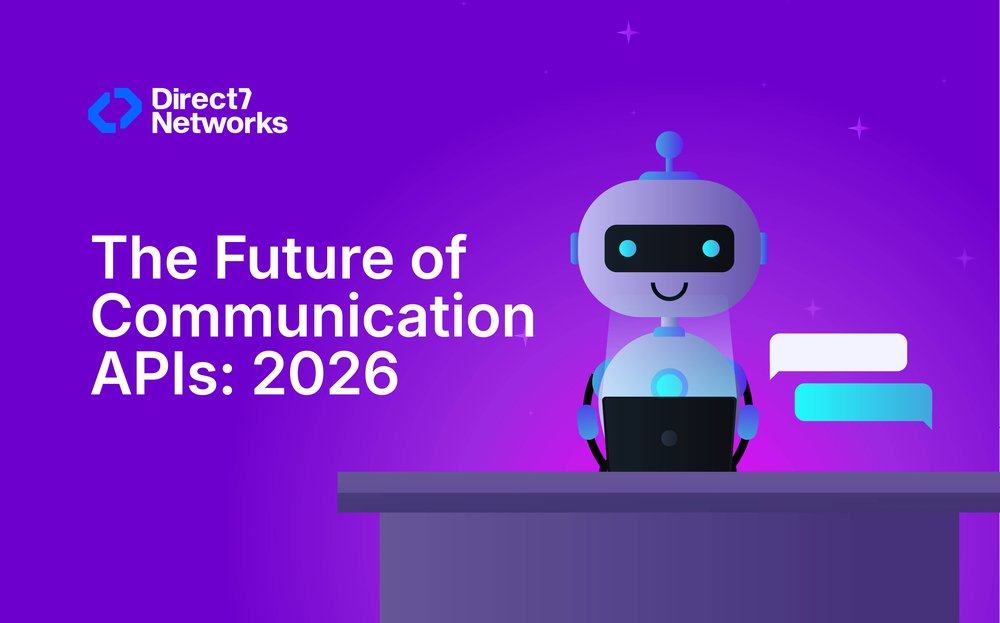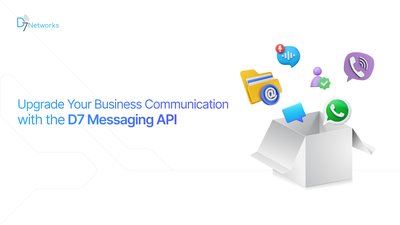Communication APIs are evolving rapidly. By 2026, expect major changes across multiple layers:
- AI-driven decision logic
- Platforms focused on orchestration (not just sending)
- Stricter rules on data use and compliance
- Pricing models tied to outcomes rather than raw volume
This guide highlights the key trends, explains why they matter, and shows practical steps you can take today.
AI Becomes Part of Send Logic—Not Just a Nice Extra
Why It Matters
By 2026, AI will do far more than generate marketing copy. It will play a core role in decision-making, including:
- Choosing the best channel (SMS, WhatsApp, email, push)
- Predicting the best time to send for each user.
- Deciding which content to show.
- Pausing or slowing contact to avoid fatigue and protect deliverability.
Today, vendors are already adding machine learning (ML) for timing, segmentation, and personalization. In the future, these features will mature into full-scale automated decisioning.
What to Expect in 2026
- Per-user send-time prediction and channel selection built into platforms.
- Real-time campaign adaptation based on user signals (opened, clicked, replied).
- AI-powered recommendations on who to skip or slow down for long-term engagement and lifetime value.
What to Do Now
✔ Instrument your sends → Track opens, clicks, replies, conversions, and opt-outs per user so ML models can learn.
✔ Run ML pilots → Start with small tests on send-time optimization or channel choice for a subset of your traffic.
✔ Maintain human override → Ensure operators can pause, adjust, or override AI-driven decisions when needed.
Summary: AI is shifting from an “add-on” to the decision engine of communication platforms. By preparing with strong instrumentation and small pilots, you’ll be ready to scale automated decisioning safely.
Retrieval-Augmented Generation (RAG) Powers Accurate, Personalized Replies
Why It Matters
Generative AI is powerful but prone to hallucinations (confident but incorrect answers). Retrieval-Augmented Generation (RAG) fixes this by fetching exact passages from your internal knowledge base or order database before generating a reply.
RAG ensures answers are:
- Grounded in company data.
- Consistent with policies.
- Auditable and explainable.
This approach is quickly becoming the standard for agent assist tools and conversational APIs.
What to Expect in 2026
- Conversational APIs with built-in connectors to knowledge bases and order systems.
- Outbound and bot messages that cite or mirror internal passages, minimizing errors.
Enterprises treating knowledge base content like software—versioned, governed, and audited.
What to Do Now
✔ Start a small knowledge base (KB) project → Tag high-value documents, policies, and common ticket responses.
✔ Prototype a RAG flow → Test on one use case (e.g., order status or returns) and measure hallucination rates.
✔ Set up content ownership → Create clear workflows so KB updates are fast, accurate, and auditable.
Summary: By grounding generative AI in your company’s knowledge, RAG turns chatbots and APIs into trustworthy, auditable tools. Begin with one use case today to prepare for large-scale adoption in 2026.
CPaaS Evolves Into an Orchestration Layer
Why It Matters
Communications Platform as a Service (CPaaS) is transforming from basic API delivery (e.g., SMS and voice) into a comprehensive orchestration platform.
- Businesses now expect routing, orchestration, analytics, and AI to be integrated in one place.
- Teams want to design omnichannel flows with built-in business logic and compliance checks.
Industry analysts predict continued CPaaS growth as companies consolidate onto richer, orchestration-first platforms.
What to Expect in 2026
- Orchestration-first CPaaS → Vendors will emphasize orchestration features (e.g., channel fallbacks, template governance, AI-based scoring).
- Deep CRM and commerce integration → Plug-and-play connections with CRM, commerce, and identity platforms will become standard.
Selection by capabilities, not just price → Businesses will choose vendors based on orchestration quality, data controls, and insights, not simply the cost per message.
What to Do Now
✔ Evaluate vendors beyond price → Assess orchestration, observability, and data compliance controls.
✔ Define a canonical event model → Standardize how messages and receipts are represented across platforms so you can switch providers easily in the future.
Summary: By 2026, CPaaS will be judged less on delivery volume and more on its ability to orchestrate omnichannel messaging with intelligence and compliance built in. Preparing now with flexible event models and smart vendor evaluations ensures long-term adaptability.
Real-Time Voice, Video, and In-Chat Media Become First-Class
Why It Matters
By 2026, voice and video will be embedded directly into messaging flows. Using APIs like WebRTC, businesses can enable:
- One-tap escalation from chat to voice or video within the same thread.
- Co-browsing and screen sharing for guided support.
- Media sharing during conversations.
While these features add complexity, they also improve resolution speed, customer satisfaction, and trust—especially for sales and support teams handling sensitive or technical issues.
What to Expect in 2026
- More customer interactions will begin in chat and seamlessly escalate to voice/video with full context preserved.
- Platforms will offer session orchestration APIs for low-latency routing and recording.
Sales and support teams will increasingly use embedded calling for verification, onboarding, and troubleshooting.
What to Do Now
✔ Prototype in-chat handoffs → Start with one workflow (e.g., support escalation or guided onboarding).
✔ Enable secure session capture → Ensure your stack can record sessions and attach them to customer records safely.
Summary: Real-time media is moving from separate tools to built-in conversation flows. Businesses that prepare now will gain an edge in faster resolution and customer trust.
Privacy, Registration, and Compliance Will Steer Product Design
Why It Matters
Regulators and carriers are tightening rules globally. Businesses face growing requirements for:
- Template registration.
- Sender verification.
Strict opt-in and consent tracking.
Manual compliance is no longer enough. Companies will embed compliance checks directly into their pipelines. Analysts expect increased enforcement and rising compliance overhead, making this a driver of architectural change.
What to Expect in 2026
- Pre-send compliance hooks → Automated checks for templates, DND scrubbing, and consent validation before delivery.
- Data residency and sovereignty controls → Required for enterprise-grade messaging flows in regulated markets.
Automated audit trails → Consent and message history logging will become mandatory for large-scale programs.
What to Do Now
✔ Treat consent as a first-class data object → Always capture:
- Source of consent.
- Scope (what messages are allowed).
- Timestamp.
- Channel.
✔ Automate compliance checks → Build pre-send validations (templates, opt-ins, scrubbing) into your CI/CD pipeline for messaging flows.
Summary: Compliance is moving from a checklist item to a built-in feature of messaging platforms. Future-ready systems will treat consent as core data and enforce compliance automatically.
Pricing Will Shift Toward Outcomes and Sessions
Why It Matters
By 2026, pricing will move beyond simple “per message segment” billing. With richer messages and AI-driven value, vendors are already experimenting with:
- Session pricing (per active conversation window).
- Conversation bundles (fixed-price packages).
Outcome-based fees (e.g., per resolved ticket, per successful verification).
This shift means businesses will measure ROI differently—not cost per message, but:
- Revenue per recipient (RPR).
- Cost per resolution.
What to Expect in 2026
- Blended pricing models → Mix of per-message fees (fallback channels like SMS) and per-session pricing for richer conversations.
- New commercial models → Incentives for fewer, higher-quality contacts instead of mass low-value sending.
What to Do Now
✔ Track new metrics → Begin monitoring RPR and cost per resolved contact alongside traditional CTR and conversion.
✔ Negotiate smartly → Ask vendors for pilot pricing tied to sessions or outcomes, not just message volume.
Summary: Pricing is shifting from volume to value. Companies that prepare with outcome-based metrics will be able to negotiate smarter contracts and prove ROI clearly.
Interoperability and Canonical Conversation Models Win
Why It Matters
Customers don’t stay in one channel—they move from chat → WhatsApp → SMS → voice call. Without a canonical conversation model, businesses risk losing context mid-stream.
The future belongs to platforms that:
- Preserve state and history across channels.
- Offer canonical schemas for conversation threads.
- Enable seamless orchestration without fragmented logs.
This marks the shift from a “message API” to a true “conversation platform.”
What to Expect in 2026
- Standard schemas for threads, receipts, and user input will reduce integration debt.
- Orchestration systems will be able to replay events and reconstruct state across channels for full context.
What to Do Now
✔ Define a single conversation schema → Establish a unified data model for messages, threads, and receipts in your product.
✔ Centralize storage → Store message events and delivery receipts in one place so state can be easily rehydrated across channels
Summary: In a multi-channel world, interoperability is the differentiator. By investing early in a canonical schema and centralized conversation state, businesses will future-proof their communication strategy.
Security Moves Deeper Into the API Stack
Why It Matters
By 2026, APIs won’t just deliver messages—they’ll increasingly execute actions on customer accounts. This evolution raises critical security needs, including:
- Short-lived API keys to reduce exposure.
- Signed webhooks to validate authenticity.
- HMAC verification to prevent tampering.
- Fine-grained privilege controls separating read vs. write access.
Security will no longer sit “around” the API—it will be a mandatory part of orchestration logic.
What to Expect in 2026
- Fine-grained token scopes → Permissions split into categories like read-only, send-only, admin, and automation.
- Signed and replay-protected webhooks by default → Ensuring payloads are authentic and not reused maliciously.
- Enforced action limits → Platforms will require human confirmation for risky requests (e.g., mass credits, sensitive account actions).
What to Do Now
✔ Adopt short-lived credentials → Rotate keys frequently and minimize their lifetime.
✔ Enable HMAC-signed callbacks → Validate every webhook request before processing.
✔ Enforce privilege separation → Create separate service accounts with only the permissions they need.
✔ Limit automation keys → Prevent high-risk actions from being executed without human oversight.
Summary: Security is moving inside the API stack, not bolted on after. By implementing short-lived credentials, signed webhooks, and privilege separation today, you’ll align with the best practices that will be mandatory in 2026.
What Success Looks Like in 2026
Winning Teams Will Have:
- One source of truth for consent and preferences → No fragmented or conflicting records.
- AI that drives smarter engagement → Higher conversion rates with fewer, more relevant sends.
- RAG-backed replies → Accurate, auditable answers grounded in trusted knowledge bases.
- Orchestration across channels → Seamless state preservation when users move between SMS, WhatsApp, chat, or calls.
- Business-focused metrics → Success measured by revenue per recipient, cost per resolution, and containment rate, not just delivery counts.
Key Insight: If you invest now in data hygiene, consent infrastructure, knowledge base governance, and small AI pilots, you’ll avoid costly rework later—and scale faster when the ecosystem matures.
Quick Starter Checklist
| Action Item | Why It Matters | |
|---|---|---|
| ✔ | Record consent with time, source, and channel | Creates auditable, regulator-proof consent logs. |
| ✔ | Tag and curate a small knowledge base (KB) | Prepares for RAG pilots with clean, useful content. |
| ✔ | Pilot ML for send-time/channel choice | Builds experience with AI decisioning on safe, limited sets. |
| ✔ | Add pre-send compliance hooks per market | Prevents violations before they happen. |
| ✔ | Prototype RCS / rich templates with SMS fallback | Tests engagement lift while keeping universal reach. |
| ✔ | Track outcome metrics (RPR, cost per resolution, containment) | Shifts focus from message volume to real business value. |
The next two years won’t bring one big disruption, but a series of small, connected shifts:
- Rich message formats.
- Embedded AI decisioning.
- Stricter compliance frameworks.
- Orchestration-first platforms.
Together, these changes will redefine communication APIs.
Teams that treat data, consent, and knowledge as first-class assets will be in the best position to take full advantage of next-generation APIs in 2026.





